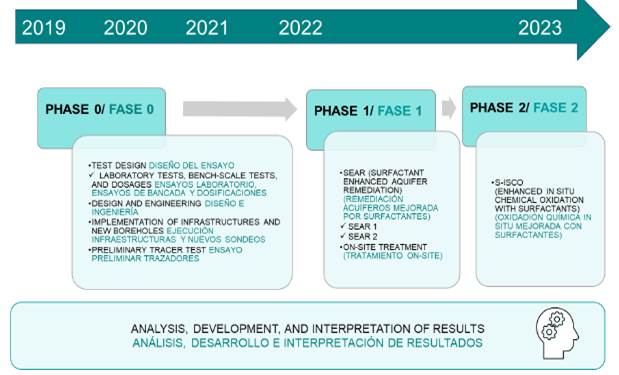The objective of the test was to demonstrate the feasibility of a technique that first enhances the on-site extraction and treatment of residual DNAPL using surfactants. Subsequently, the goal is to destroy the remaining contaminant within the rock itself by combining surfactants with oxidants. To achieve this, a pilot test was designed and implemented at the Bailín landfill, and studies were conducted for its transferability to spaces with different geological conditions and other dense phases, thus making it applicable to other sites. Following an analysis of the site based on the compiled documentation, a test cell is proposed in the designated layer M, where the presence of DNAPL is detected along a 300-meter stretch, reaching depths up to 40 meters, with a variable width between 2 and 4 meters. This layer connects the aquifer to the Gállego River, which poses a risk that will not be resolved until the residual DNAPL is eliminated. 2019-2020 Tests to establish laboratory scale conditions for the use of oxidants, surfactants and other reagents as well as their application at the field scale. Bench scale tests for the treatment of surfactant emulsions and DNAPL that can be extracted from the aquifer. Implementation of infrastructures for the field test (accesses, boreholes, injection and pumping equipment, safety barrier equipment). Initial hydrogeological and tracer tests to establish the functioning of the aquifer and the conditions under which the definitive tests are expected to be conducted. The field test is carried out on a vertical sandstone stratum, along the first 60 meters where DNAPL is considered to be present. In addition, the entire tested layer is controlled up to the Gállego river and a barrier zone is set up before the river to eliminate pollutants that may be mobilized during the test. 2021-2022 Tracer tests were conducted in the field, delimiting and analyzing hydrogeological parameters, risks, and reaction times. This helped to establish the optimal strategy for the development of pilot tests in the field. 2022: Enhanced Surfactant-based Aquifer Remediation (SEAR). The trial was conducted in two consecutive stages, SEAR-1 and SEAR-2, within the study cell section. Tests were carried out at the "On Site" location with pumped liquids and extractions, to determine the treatability of the products and pollutants. 2022-2023 2022: Prior to the S-ISCO test, a tracer test was conducted to confirm the initial situation after the SEAR execution. This facilitated the assessment of flow rates, injection times, plume mobilization and the operation of the barrier zone. In October 2022, the S-ISCO test was executed with its subsequent follow-up and monitoring according to the protocol. During this phase and throughout 2023, the information generated in the S-ISCO test was analyzed. 2023: The 14th International HCH and Pesticides Forum took place in Zaragoza (Spain), from February 21st to 24th, 2023, where 361 experts on persistent organic pollutants, obsolete pesticides and hazardous chemical waste participated, representing 68 nationalities. The program was structured in fourteen thematic sessions during three consecutive days, in three parallel rooms and on the fourth day, there was a visit to the sites of Inquinosa, Sardas and Bailín. PHASE 0 From 2019 to 2022, laboratory and bench-scale tests were carried out with the aim to define the optimal blend of reagents, surfactants, and appropriate treatments for the extracted products. The design and engineering of the test were done. Despite the challenges caused by the pandemic, equipped infrastructures and new boreholes were executed. PHASE 1 2022. Two enhanced surfactant-based remediation (SEAR) field tests were conducted, extracting the maximum possible volume of surfactant emulsion and DNAPL through pumping. Various elimination methods were tested on these emulsions, including Fenton, alkaline hydrolysis with aeration, and retention on activated carbon followed by degradation with oxidants. PHASE 2 2022. This phase involved the injection of a mixture of oxidant (activated sodium persulfate with caustic soda) and surfactant (emulse®) to eliminate both dissolved contaminants and any residual DNAPL remaining in the aquifer after washing in the SEAR phase. Initially, the application of In-Situ Chemical Oxidation (ISCO) treatment was considered in a subsequent Phase 3 to treat a potential "rebound," which occurs when contaminants embedded in the rock equilibrate with groundwater, leading to an increase in pollution. Subsequent monitoring of the water has shown that concentrations have remained low. All phases were executed in accordance with protocols and subsequent monitoring. The use of surfactants (industrial soaps) consists in mobilizing contaminants to oxidize them. To avoid the leak of pollution out from the test area, an area for the injection of oxidants and aeration in boreholes has been created 300m downstream the test area. This way, the sealing of the vertical rock layer is ensured. LIFE funds commit with the lindane challenge. In conclusion, this EU contribution, via LIFE funds, will allow for the increase of the safety conditions of the old Bailin landfill and of the use of water of the Gallego river. LIFE funds come from the European Union and its objective is the development of pilot tests of new technologies not tested before on field, either tested under new conditions. It has a demonstrative character and it gives value to projects whose results are transferable to other locations with similar environmental challenges. The collaboration among partners of different countries is therefore a key aspect of the project. The LIFE SURFING proposal was one of the selected ones among 507 proposals submitted in the environmental area.NEW LIFE TEST
What is the test about?
Chronology of the test
Test phases
Barrier zone
This website uses cookies so that we can provide you with the best user experience possible. Cookie information is stored in your browser and performs functions such as recognising you when you return to our website and helping our team to understand which sections of the website you find most interesting and useful.



